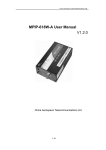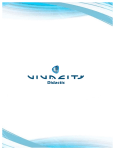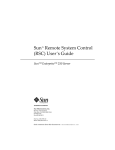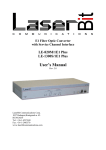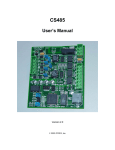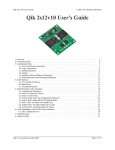Download HDV100A3 Command Response Protocol
Transcript
HDV100A3 Command Response Protocol Documentation Number: HDV100A3-0812CR International Headquarters B&B Electronics Mfg. Co. Inc. 707 Dayton Road -- P.O. Box 1040 -- Ottawa, IL 61350 USA Phone (815) 433-5100 -- General Fax (815) 433-5105 Home Page: www.bb-elec.com Sales e-mail: [email protected] -- Fax (815) 433-5109 Technical Support e-mail: [email protected] -- Fax (815) 433-5104 B&B Electronics -- June 2008 HDV100A3 Command & Response Manual Cover Page B&B Electronics -- 707 Dayton Rd. -- PO Box 1040 -- Ottawa, IL 61350 PH (815) 433-5100 -- FAX (815) 433-5104 Table of Contents INTRODUCTION ........................................................................................ 1 OPERATION ............................................................................................... 1 Command Protocol ................................................................................ 2 Formatting the Control Bytes................................................................. 3 DETAILED DESCRIPTION OF GENERAL FUNCTION CODES ....... 4 Command Acknowledgement ................................................................. 4 RS-232 Baud Rate Setup ........................................................................ 5 Setting Baud 1, Baud 2........................................................................... 7 Baud Rate Example ................................................................................ 8 Time Stamp Information ......................................................................... 9 Master Reset Command ....................................................................... 11 Vendor Information .............................................................................. 11 J1708 COMMANDS .................................................................................. 12 Receiving Data from the J1708 Bus ..................................................... 12 Transmitting Data to the J1708 Bus .................................................... 14 Set Filter Active .................................................................................... 15 Set Filter Off......................................................................................... 16 Broadcast Message .............................................................................. 17 J1939 COMMANDS .................................................................................. 19 Start Receive on J1939 Bus .................................................................. 20 Stop Receive on J1939 Bus .................................................................. 20 Arbitration Field (Y1, Y2, Y3, Y4) ........................................................ 21 Transmit Data to J1939 Bus ................................................................ 23 Set Mask ............................................................................................... 23 Set Filter 1 to 4 .................................................................................... 24 J1939 Header Worksheet ..................................................................... 26 ERROR CODES ........................................................................................ 27 HDV100A3 Command & Response Manual Table of Contents B&B Electronics -- 707 Dayton Rd. -- PO Box 1040 -- Ottawa, IL 61350 PH (815) 433-5100 -- FAX (815) 433-5104 i WARNING! This Model HDV100A3 Converter Module allows you to connect to active J1708 / J1939 networks. It is possible that your transmissions through this converter module could cause malfunction of the network operation, damage to software or equipment, or bodily harm. Do Not Transmit Any Messages to the network without a complete understanding of the operation of the network. B&B Electronics Mfg. Co. specifically disclaims any responsibility for damage or injury to software, hardware, equipment or persons as a result of using this product. WARNING! ii HDV100A3 Command & Response Manual B&B Electronics -- 707 Dayton Rd. -- PO Box 1040 -- Ottawa, IL 61350 PH (815) 433-5100 -- FAX (815) 433-5104 Introduction The HDV100A3 works with a command protocol to send and receive data from J1708/J1587 and J1939 vehicle networks. Networks can be addressed individually or to/from both at once if they are both present on the vehicle. Note that the HDV100A3 is powered from the vehicle side of the interface. If the device is to be used without a vehicle, it will be necessary to connect power to the device through the 15-pin connector. Positive voltage is connected on pin 8. Pin 7 is connected to ground. Operation The HDV100A3 performs several functions in order to reduce the overhead and timing requirements of the host application when communicating with the J1708 and J1939 bus. The device handles collision detection and retries with no additional interaction from the host application. This greatly reduces the processor overhead required by the host in order to communicate efficiently with the vehicle bus. HDV100A3 Command & Response Manual B&B Electronics -- 707 Dayton Rd. -- PO Box 1040 -- Ottawa, IL 61350 PH (815) 433-5100 -- FAX (815) 433-5104 1 Command Protocol The HDV100A3 uses a simple protocol to communicate to vehicle bus. The protocol is divided into four parts: Start Of Frame (SOF) Control Field (shown in light gray) Data Field (shown in dark gray) Checksum (CS) SOF 1 byte Intelligent Mode Message Structure Number of Control Bytes Number of Control Bytes Data Bytes 1 byte 1 to 20 bytes 1 byte Data Bytes CS 1 to 100 bytes 1 byte The Start of Frame byte is the first byte in a valid frame and is always 01 hex. The Control Field sets up the function and control of the HDV100A3 hardware and is formatted as shown below. Control Field Structure Number of Control ID Byte Function Byte Bytes to Follow 1 byte 1 byte 1 byte Control Data Bytes Up to 20 bytes The first byte of the Control Field is the number of control bytes in the message. This value indicates the number of control bytes, excluding itself, to follow. If the message doesn’t contain any control bytes, the Number of Control Bytes value will be set to 00 hex as a placeholder. The next part of the message frame is the data field. The data field is preceded by the number of data bytes, excluding itself, to follow and is set to 00 hex if no data is present in the message. The data field is reserved for data that is to be communicated to the vehicle bus. Data Field Structure Number of Data Bytes Data Bytes 1 byte Up to 100 bytes The last element of a valid message is the checksum. The checksum is calculated by adding ALL bytes from the Start of Frame (inclusive) to the last data byte and using the last 8 bits as a checksum. 2 HDV100A3 Command & Response Manual B&B Electronics -- 707 Dayton Rd. -- PO Box 1040 -- Ottawa, IL 61350 PH (815) 433-5100 -- FAX (815) 433-5104 Formatting the Control Bytes The 2nd byte is “Number of Control Bytes” to follow and always precedes the control field. The third byte is the ID byte. This byte tells the hardware where to direct the message. Valid entries for functions are: ID Codes =01 Message for J1708 =02 Message for J1939 =08 General message (for control of the HDV100A3 device) =05 Device identification (reverse compatible) The fourth byte is the function byte. The functions that are supported are listed below. Note that some of the function codes are followed by additional bytes of information. These bytes must be included in the control byte count. Valid General Function Codes Function codes =01 change PC baud rate, followed by 3 bytes (UB3, Baud1, Baud2) =02 send time stamp =04 hardware handshaking =08 reset converter, followed by 2 bytes (01,and 02) =10 time stamp off =20 time stamp on Valid Entries for J1708 Functions Function codes = 07 set broadcast message = X8 set filter X off = X9 set filter X on = 11 Sync with J1708 bus and start reception = 10 Stop reception = 12 Transmit to J1708 bus Valid Entries for J1939 Functions Function codes =00 Receive off =01 Receive on =02 Transmit message =08 Set mask =X8 set filter X off =X9 set filter X on HDV100A3 Command & Response Manual B&B Electronics -- 707 Dayton Rd. -- PO Box 1040 -- Ottawa, IL 61350 PH (815) 433-5100 -- FAX (815) 433-5104 3 Detailed Description of General Function Codes Command Acknowledgement All commands sent to the device will be acknowledged. If no error occurs an ACK will be sent with the ID byte that accompanied the command. If an error occurred, a NACK will be sent with the ID byte that accompanied the command as well as a Function code of $05 and the Error Code. The responses will not be shown for each command since it is the same for almost all commands. Below is the format of the ACK/NACK response. If an ACK/NACK response is different for a particular command, it will be specified. ACK/NACK Format: Byte Byte Number Value 1 01 2 01 or 03 3 aa 4 bb 5 cc 6 00 7 CS Function Start of frame Number of control bytes = 1 for ACK, 3 for NACK ID byte 08 = internal command Function code 02 = send time stamp Number data bytes Checksum aa – ID Byte $01 = J1708 Interface $02 = J1939 Interface $05 = Device Id $08 = RS-232 Interface $09 = Message Xmit OK Response bb – FC Byte None = Command Received and Valid $05 = A error was detected, NACK cc – CD Byte None = No Error Condition Error Code = See Section 5.10 4 HDV100A3 Command & Response Manual B&B Electronics -- 707 Dayton Rd. -- PO Box 1040 -- Ottawa, IL 61350 PH (815) 433-5100 -- FAX (815) 433-5104 RS-232 Baud Rate Setup To set the baud rate for the RS-232 port, set a general command code of 08. Set the function code to 01. Then set 3 control bytes as follows. Function Start of Frame Byte # 1 Value 01 Control Command Function UB3 Baud Baud Data Check Bytes Code Code 1 2 Bytes Sum 2 05 3 08 4 01 5 6 8 9 00 10 Setting UB3 Bit 7 Divisor Latch Bit 6 Set Break Bit 5 Set Parity Bit 4 Even Parity Bit 3 Parity Enable Bit 2 Stop Bits Bit 1 Word Length 1 Bit 0 Word Length 0 Bit 7 = 1 allows baud rate divisor to be changed. 0 baud rate change is blocked. Bit 7 should not be set. The setting and resetting of this bit is handled internally. Bit 6 = 1 forces the transmitter output to a logic 0 for alerting the remote receiver to a line break. 0 indicates no break condition. Bit 5, 4 and 3 work together to set parity Bit 5 * 0 0 1 1 Bit 4 Bit 3 * 0 0 1 1 1 0 1 1 1 *Don’t care state. Parity Selection No parity (default) Odd parity Even parity Force parity “1” Force parity “0” Bit 2, stop bit, works in conjunction with bits 1 and bit 0 Bit 2 0 1 1 Word Length (bits) 5,6,7,8 5 6,7,8 Stop Bit Length 1 (default) 1½ 2 HDV100A3 Command & Response Manual B&B Electronics -- 707 Dayton Rd. -- PO Box 1040 -- Ottawa, IL 61350 PH (815) 433-5100 -- FAX (815) 433-5104 5 Bits 1 and 0 set the word length Bit 0 0 0 1 1 Bit 1 0 1 0 1 Word Length 5 6 7 8 (default) Default value. The HDV100A3 should always be set to 8-bit word length. 6 HDV100A3 Command & Response Manual B&B Electronics -- 707 Dayton Rd. -- PO Box 1040 -- Ottawa, IL 61350 PH (815) 433-5100 -- FAX (815) 433-5104 Setting Baud 1, Baud 2 Baud Rate Setup Table Baud Rate 9600 14400 19200 38,400 57,600 115,200 230,400 460,800 Decimal Divisor 48 32 24 12 8 4 2 1 Hex Divisor MSB (Baud 2) $00 $00 $00 $00 $00 $00 (default) $00 $00 Hex Divisor LSB (Baud 1) $30 $20 $18 $0C $08 $04 (default) $02 $01 All baud rates are entered as hex numbers. To calculate your own decimal divisor use the following formula. The decimal number must be converted to hexadecimal before entering the number. Baud rates below 9,600 are not recommended because of the difference in speed between the vehicle bus and PC serial port. The UART clock = 7,372,800 Hz Decimal Divisor = Clock frequency ( 7,372,800) Baud output x 16 If you want a baud rate of 9,600 baud Decimal Divisor = 7,372,800 9,600 x 16 Decimal Divisor = 48 = 30 hex Baud 1= 30 Baud 2= 00 HDV100A3 Command & Response Manual B&B Electronics -- 707 Dayton Rd. -- PO Box 1040 -- Ottawa, IL 61350 PH (815) 433-5100 -- FAX (815) 433-5104 7 Baud Rate Example To set the PC baud rate to 57,600 baud, N,8,1, format the message as follows. Byte Number 1 2 3 4 5 6 7 8 9 Byte Value Hex 01 05 08 01 03 08 00 00 1A Byte Function Start of frame Number of control bytes Command byte (08 = internal command) Function Bbte (01 = change baud) UB3 Baud 1 Baud 2 Number of data bytes Checksum The first byte is the start of frame and always 01. Next is the number of control bytes (05). There are 5 bytes in the control section (in gray). Byte number 3 sets the HDV100A3 to an internal operation (08). Byte 4 is the internal function to be executed; (01) is the change baud command. Bytes 5, 6, and 7 set the baud rate, parity, stop bits and word length. Next is the number of data bytes, in this case there are no data bytes. Last is the checksum, the value is the 8 bit addition of bytes 1 to 8. 8 HDV100A3 Command & Response Manual B&B Electronics -- 707 Dayton Rd. -- PO Box 1040 -- Ottawa, IL 61350 PH (815) 433-5100 -- FAX (815) 433-5104 Time Stamp Information The HDV100A3 supports a four-byte rolling time stamp with a resolution of 1.5 microseconds per bit. The maximum time stamp value is 6,442.45 seconds before roll over. The 4-byte time stamp will be added to all transmission from the bus. The time stamp will be added to the transmission confirmation message. The host application can request that the HDV100A3 send a time stamp, formatted as follows. Byte Number 1 2 3 4 5 6 Byte Value 01 02 08 02 00 0D Function Start of frame Number of control bytes ID byte 08 = internal command Function code 02 = send time stamp Number data bytes Checksum Reply from HDV100A3 Byte Number 1 2 3 4 5 6 7 8 9 Byte Value 01 05 0A XX XX XX XX 00 CS Function Start of frame Number of control bytes ID 0A = time stamp Time msb Time msb-1 Time msb – 2 Time lsb Data bytes 00 Checksum The time stamp is attached to all messages received from the vehicle bus as part of the control header. After the start of frame byte, the number of control bytes, ID byte and the next 4 bytes are the time stamp. The fourth byte is the MSB the seventh byte is the LSB. Message time stamping is the default condition when the HDV100A3 is placed in the smart mode. To stop the time stamp from being added to the J1708 message, send the following command to the HDV100A3. HDV100A3 Command & Response Manual B&B Electronics -- 707 Dayton Rd. -- PO Box 1040 -- Ottawa, IL 61350 PH (815) 433-5100 -- FAX (815) 433-5104 9 Byte Number 1 2 3 4 5 6 Byte Value 01 02 08 20 00 2B Function Start of frame Number of control bytes ID byte 08 = internal command Function code 20 = stop time stamping Number data bytes Checksum To resume time stamping send the following command: Byte Number 1 2 3 4 5 6 Byte Value 01 02 08 10 00 1B Function Start of frame Number of control bytes ID byte 08 = internal command Function code 10 = resume time stamping Number data bytes Checksum Time stamping will resume after reset. 10 HDV100A3 Command & Response Manual B&B Electronics -- 707 Dayton Rd. -- PO Box 1040 -- Ottawa, IL 61350 PH (815) 433-5100 -- FAX (815) 433-5104 Master Reset Command The master reset command allows the HDV100A3 to be reset from the PC. Sending this command resets the HDV100A3 to the default mode (dumb mode). You will lose all setting sent in the smart mode. Byte Number 1 2 3 4 5 6 7 8 Byte Value 01 04 08 08 01 02 00 18 Function Start of frame Number of control bytes ID byte 08 = internal command Function code 08= master reset Check byte Check byte Number data bytes Checksum Note after sending a master reset the baud rate is 115.2 kbps. Vendor Information To receive the vendor information from the HDV100A3 send hex (01, 01, 05, 00, 07) to the device. It will respond as follows: Hex (01, 0B, 85, MM, DD, MA, M1, M2, MO, 00, VV, VV, 00, DB, CS) 0B = Number of control bytes 85 = Compatibility with other models MM = Month firmware was created DD = Day firmware was created MA = Major firmware revision number M1 = MSB of minor firmware revision M2 = LSB of firmware revision MO = Model VV = Customer code 1 VV = Customer code 2 DB = Number of data bytes CS = Checksum HDV100A3 Command & Response Manual B&B Electronics -- 707 Dayton Rd. -- PO Box 1040 -- Ottawa, IL 61350 PH (815) 433-5100 -- FAX (815) 433-5104 11 J1708 Commands Receiving Data from the J1708 Bus After the HDV100A3 is set into its Intelligent mode of operation and the RS-232 data rate is configured, you are now ready to communicate with the J1708 bus. A receive command must be sent to the HDV100A3 before attempting to transmit to the bus. The receive message synchronizes the HDV100A3 with the bus. To start receiving J1708 bus data, send the following to the HDV100A3. Byte Number 1 2 3 4 5 6 Byte Value (hex) 01 02 01 11 00 15 Byte Function Start of frame The number of control bytes ID byte 01= J1708 Function code 11 hex start receive Number of data bytes (00 place holder) Checksum (bytes 1 through 5 added together) After sending this command to the device, the device will respond with a confirmation message. The message confirms that the command was received by the HDV100A3 and the checksum verified correctly. The reply from the device is formatted as follows: Byte Number 1 2 3 4 5 Byte Value (hex) 01 01 01 00 03 Byte Function Start of frame byte Control byte ID byte (ID of the sent message) Number of data bytes Checksum The confirmation message is sent in response to a command sent to the device. The ID byte and the check-sum will change with different commands but the format will remain the same. If the checksum is not correct an error message is sent. Its format is covered at the end of this document. 12 HDV100A3 Command & Response Manual B&B Electronics -- 707 Dayton Rd. -- PO Box 1040 -- Ottawa, IL 61350 PH (815) 433-5100 -- FAX (815) 433-5104 Below is an example of a vehicle message: Byte Number 1 2 3 4 5 6 7 8 9 10 11 12 13 14 15 16 Byte Value (hex) 01 05 01 03 D3 2B AB 07 80 54 4D BE B8 1A 4F BA Byte Function Start of Frame # of Control Bytes Control Byte Timestamp Timestamp Timestamp Timestamp # of Data Bytes MID PID Data PID Data Data J1587 Checksum (2’s Compliment) Message Checksum PIDs with a range of 0 – 127 and 256 – 383 will return 1 data byte. PIDs with a range of 128 – 191 and 384 – 447 will return 2 data bytes. PIDs with a range of 192 – 253 and 448 – 509 will return variable data bytes. For further description of MIDs and PIDs refer to SAEJ1587 document. To stop receiving data from the J1708 bus send the following command to the HDV100A3. Byte number 1 2 3 4 5 6 Byte value (hex) 01 02 01 10 00 14 Byte Function Start of frame The number of control bytes ID byte 01= J1708 Function code 10 hex stop receive Number of data bytes (00 place holder) Checksum (bytes 1 through 5 added together) After sending this command to the device, the device will respond with a confirmation message and data will cease. Note that there is the possibility of an incomplete message being sent to the PC after sending this command. Use the check-sum to verify all messages. HDV100A3 Command & Response Manual B&B Electronics -- 707 Dayton Rd. -- PO Box 1040 -- Ottawa, IL 61350 PH (815) 433-5100 -- FAX (815) 433-5104 13 To restart reception, send the (01, 02, 01, 11, 00, 15) command to the HDV. Transmitting Data to the J1708 Bus The HDV100A3 supports standard J1708 commands of up to 21 bytes. Additionally the HDV100A3 can send messages up to 100 bytes to the J1708 bus. It is the responsibility of the sending software to check for “ignition off” before using the J1708 bus to send messages with more than 21 bytes to the bus. Failure to check for a “quiet bus” condition before transmitting a long message may cause erratic bus operation. The format to send information to the J1708 bus is shown below: Byte Number 1 2 3 4 5 6 Byte Value (hex) 01 03 01 12 02 XX YY CS Byte Function Start of frame Number of control bytes ID bytes 1= J1708 Function code 12 (hex) transmit to J1708 bus Priority byte 00000010 set bit 0 to 7 see below Number of data bytes to follow (excludes checksum byte) Data bytes up to 100 bytes Checksum Set the priority bit using the chart below. Priority Byte Value 1 2 3 4 5 6 7 8 14 Binary Value 00000001 00000010 00000100 00001000 00010000 00100000 01000000 10000000 Hex Value 01 02 04 08 10 20 40 80 HDV100A3 Command & Response Manual B&B Electronics -- 707 Dayton Rd. -- PO Box 1040 -- Ottawa, IL 61350 PH (815) 433-5100 -- FAX (815) 433-5104 After sending a transmit message to the HDV100A3 you will get the confirmation message if the checksum is correct. A transmit complete message is sent to the PC after the device successfully transmits the message to the J1708 bus. A second message should not be sent to the device before confirming that the first message has been sent. The transmit confirmation is formatted as follows: Byte Number 1 2 3 8 9 Byte Value (hex) 01 01 09 00 0B Byte Function Start of frame Number of control bytes ID bytes 9 = transmit OK Number of data bytes Checksum J1708 Message Filter The J1708 message filter will operate on 4 different MID’s. Only messages with the same MID as set in the filter will be sent to the PC. The filters will be OR’ed together so that multiple MID’s can be filtered, MID1 or MID2 or MID3. The format for the setting of J1708 filtering is as follows: Set Filter Active Byte Byte Function Number Value 1 2 3 4 5 6 7 01 03 01 X9 XX 00 CS Start of frame Control bytes ID byte 1 = J1708 message Set filter 9 = Set filter active Value of MID to filter On Data bytes Checksum X = filter number 1 to 4 HDV100A3 Command & Response Manual B&B Electronics -- 707 Dayton Rd. -- PO Box 1040 -- Ottawa, IL 61350 PH (815) 433-5100 -- FAX (815) 433-5104 15 Set Filter Off Byte Byte Number Value Function 1 2 3 4 6 7 Start of frame Control bytes ID byte 1 = J1708 message Set filter 8 = Set filter inactive Data bytes Checksum 01 02 01 X8 00 CS X = filter number 1 to 4 Setting all filters off will stop all data from the J1708 bus. When all filters are set off you must send the receive J1708 command to start receiving all bus messages. 16 HDV100A3 Command & Response Manual B&B Electronics -- 707 Dayton Rd. -- PO Box 1040 -- Ottawa, IL 61350 PH (815) 433-5100 -- FAX (815) 433-5104 Broadcast Message The HDV100A3 supports one broadcast message. Once configured by the host application, this message will be sent repeatedly by the HDV100A3 at a programmed time interval. This feature is useful to provide a “heartbeat” function to the J1708 bus with no overhead to the host application’s software. Sending 0 in the time value stops the broadcast message from being sent. To start a broadcast message the time interval, message slot, priority, number of data bytes, and the data must be sent to the HDV100A3. Once sent, the HDV100A3 will send the message out on the bus at the specified interval. Existing bus traffic or any bus messages sent to the HDV100A3 from the host application take priority over a pending broadcast message. Once a broadcast message is started the “Stop Broadcast 07” message must be sent before any changes to the broadcast message can be made. Changing from one time value (17) to another (37) without stopping the broadcast will cause the HDV100A3 to act erratically. Byte Number Byte Value Function 1 2 3 4 5 6 7 01 04 01 X7 0X PP YY DATA CS Start of frame Control bytes ID byte 1 = J1708 message Set broadcast 7 = On X = Time interval (see chart) Message slot number (01 only active at this time) Priority (see chart below) Data bytes From 4 to 21 bytes Checksum HDV100A3 Command & Response Manual B&B Electronics -- 707 Dayton Rd. -- PO Box 1040 -- Ottawa, IL 61350 PH (815) 433-5100 -- FAX (815) 433-5104 17 To stop broadcast transmission it is not necessary to send the whole message. The message below will stop broadcast transmission. Byte Number Byte Value Function 1 2 3 4 7 8 01 02 01 07 00 0B Start of frame Control bytes ID byte 1 = J1708 message Set broadcast 7 = On X = Time interval (see chart) Data bytes Checksum Byte 4 Values Byte Value 07 17 27 37 47 Time Value Stop broadcast .5 sec. 1.0 sec 1.5 sec 2.0 sec Byte 6 (Priority) Values Byte Value (hex) Byte Value Binary Priority 01 02 04 08 10 20 40 80 00000001 00000010 00000100 00001000 00010000 00100000 01000000 10000000 1 2 3 4 5 6 7 8 18 HDV100A3 Command & Response Manual B&B Electronics -- 707 Dayton Rd. -- PO Box 1040 -- Ottawa, IL 61350 PH (815) 433-5100 -- FAX (815) 433-5104 J1939 Commands The J1939 protocol is similar to the J1708 protocol. The message starts with Start of Frame byte 01. The number of control bytes will be 06. The control code for J1939 is 02. The function codes (XX) are as follows: 00=Sets receive function off 01=Sets receive on 02=Transmits a message with data 04=Set mask 19=filter 1 set on 18=filter 1 set off 29=filter 2 set on 28=filter 2 set off 39=filter 3 set on 38=filter 3 set off 49=filter 4 set on 48=filter 4 set off Function codes are shown in detail below. Before operating the HDV100A3 in the J1939 mode it is recommended that the baud rate be set to 115.2kb. This is done by sending the following code: (01, 05, 08, 01, 03, 04, 00, 00 16). After sending this command the baud rate of the sending device (PC) must also be changed. Because of the difference in baud rates between the J1939 bus and the RS-232 serial bus, the HDV100A3 may miss messages on the J1939 bus. This depends on bus load, message length, and filter settings. Sending any message with a control code of (02) to the J1939 bus stops the operation on the J1708 bus. If you wish to restart operation on the J1708 bus you must send the start J1708 reception message (01, 02, 01, 11, 00, 15). Sending this message stops operation on the J1939 bus. Function codes 00 and 01, Receive OFF, ON operate together to control a receive register. Sending the command (01, 02, 02, 01, 00, 06) starts reception on the J1939 bus. This command resets the filter mask to all zeros (don’t care). All bus traffic is then received. However, it may not be possible to send all messages to the PC side. Any message that is not serviced before the next message is received will be overwritten by the new message. Sending the command (01, 02, 02, 00, 00, 05) turns off the receiver. It is HDV100A3 Command & Response Manual B&B Electronics -- 707 Dayton Rd. -- PO Box 1040 -- Ottawa, IL 61350 PH (815) 433-5100 -- FAX (815) 433-5104 19 wise to set the receiver off when not in use. Sending the Start Receive clears the mask. This renders the filter function useless. Start Receive on J1939 Bus Byte Byte Function Number Value 1 01 Start of frame 2 02 Control bytes 3 02 ID byte 02 = J1939 message 4 01 Function code 01 start reception 5 00 Data bytes 6 06 Checksum Stop Receive on J1939 Bus Byte Number 1 2 3 4 5 6 20 Byte Value 01 02 02 00 00 05 Function Start of frame Control bytes ID byte 02 = J1939 message Function code 00 stop reception Data bytes Checksum HDV100A3 Command & Response Manual B&B Electronics -- 707 Dayton Rd. -- PO Box 1040 -- Ottawa, IL 61350 PH (815) 433-5100 -- FAX (815) 433-5104 Data messages received from the HDV100A3 operating in the J1939 mode, is formatted as follows: Control Field Data Field Start # of Contr Time Stamp # of Arbitration of Control Byte 4 Bytes Data Field Frame bytes Bytes 01 05 02 msb # of Data Bytes in Message lsb ZZ Y1 Y2 Y3 Y4 0X Bus Data Up to 8 Bytes Check sum The message starts with 01. The number of control bytes is 05. Next is the control byte 02, followed by the time stamp, four bytes, with msb first. The number of data bytes is the number of bytes to follow excluding itself and the checksum byte. Next is a four byte that contains the arbitration field. J1939 divides this field for different functions show in the chart below. The number of data bytes sent by the bus is next. This will be a value between 0 and 8. Next is the bus data followed by the checksum byte. Arbitration Field (Y1, Y2, Y3, Y4) The first byte Y1 contains the most significant bits in the J1939 arbitration field. It is followed by Y2, Y3 and Y4. J1939 assigns different function to the arbitration field that must be observed by the user. There is a work sheet included on page 33 to help set up this field. Arbitration Byte Arbitration Bit Y1 Y2 Y3 Y4 7 6 5 4 3 2 1 0 7 6 5 4 3 2 1 0 7 6 5 4 3 2 1 0 7 6 5 4 3 2 1 0 J1939 Arbitration Field 29 28 27 26 25 24 23 22 21 20 19 18 17 16 15 14 13 12 11 10 9 8 7 6 5 4 3 2 1 Bit Position J1939 Function Priority R D PDU Format PDU Specific Source Address bits P HDV100A3 Command & Response Manual B&B Electronics -- 707 Dayton Rd. -- PO Box 1040 -- Ottawa, IL 61350 PH (815) 433-5100 -- FAX (815) 433-5104 21 A message received from the HDV will be formatted as follows: <01><05><02><06><C7><CC><ED><0D><67><80><20><00><08><F0><7D><DA><00> <00><FF><FF><DA><C9> The < > are placeholders and are NOT transmitted with the data. ** = value changes with message. Byte Number 1 2 3 4 5 Byte Value 01 05 02 06 C7 Function 6 7 8 9 10 11 12 13 14 15 16 17 18 19 20 21 22 CC ED 0D 67 80 20 00 08 F0 7D DA 00 00 FF FF DA C9 Time stamp MSB –2 ** Time stamp LSB ** Number of data bytes to follow (13 dec) ** First byte of arbitration field ** Second byte of arbitration field ** Third byte of arbitration field ** Fourth byte of arbitration field ** Number of data bytes in bus message ** Data bytes ** Data bytes ** Data bytes ** Data bytes ** Data bytes ** Data bytes ** Data bytes ** Data bytes ** Checksum ** Start of frame Control bytes ID byte 02 = J1939 message Time stamp MSB ** Time stamp MSB –1 ** Function code 02 sends data to the J1939 bus. The transmit code is set up as follows: (01, 06, 02, 02, XX, XX, XX, XX, DD, YY, YY, YY, YY, YY, YY, YY, YY, CS). The header starts with 01. There are six control bytes (06). The control code is (02). The transmit command is (02). The arbitration field is filled out as shown above. There is also a worksheet to help fill out this field. Next is the number of data bytes in the data payload. The data payload for the message is entered in the data field. After a transmission is successfully sent out and confirmed by at least one active node, an acknowledge message is sent to the PC (01, 01, 02, 00, 04). There is a form on page 33 to help set up the arbitration field. 22 HDV100A3 Command & Response Manual B&B Electronics -- 707 Dayton Rd. -- PO Box 1040 -- Ottawa, IL 61350 PH (815) 433-5100 -- FAX (815) 433-5104 Transmit Data to J1939 Bus Byte Number 1 2 3 4 5 6 7 8 9 Byte Value 01 06 02 02 XX XX XX XX DD DATA CS Function Start of frame Control bytes ID byte 1 = J1708 message Function byte 02 transmit message MSB of arbitration field (J1939 priority bits) MSB-1 MSB-2 LSB of arbitration field (J1939 source address) Number of data bytes From 0 to 8 bytes Checksum Set Mask Function code 04 set mask. The mask is applied to ALL filters. The mask is 32 bits long. The last 3 bits are not used and must be set to zero. This mask covers the 29-bit arbitration field. To use the filter function, the mask must be set. The mask determines what position(s) will be tested and matched to the incoming message. If a 1 is set in a particular position, that position will be tested. It will be “and” with any active filters to determine if the message will be passed to the PC side. Any position marked with a 0 is a “don’t care” position and will pass all data in that position. There is a form on page 33 that helps set up the mask for the arbitration field. Byte Number 1 2 3 4 5 6 7 8 9 10 Byte Value 01 06 02 04 XX XX XX XX 00 CS Function Start of frame Control bytes ID byte 02 = J1939 Function byte 04 set mask MSB of arbitration field (J1939 priority bits) MSB-1 MSB-2 LSB of arbitration field (J1939 source address) Number of data bytes Checksum HDV100A3 Command & Response Manual B&B Electronics -- 707 Dayton Rd. -- PO Box 1040 -- Ottawa, IL 61350 PH (815) 433-5100 -- FAX (815) 433-5104 23 The mask can be used to look at a group of messages: To set the mask to filter on the J1939 priority field, the mask would be loaded with: (01, 06, 02, 04, E0, 00, 00, 00, 00, ED) To set the mask to filter on the J1939 PGN field, the mask would be loaded with: (01, 06, 02, 04, 07, FF, F8, 00, 00, 0B) To set mask to filter on both the priority field and the PGN field the mask would be loaded with: (01, 06, 02, 04, B7, FF, F8, 00, 00, BB) Set Filter 1 to 4 Function codes 18 and 19, 28 and 29, 38 and 39, 48 and 49 are filter pairs. These filters are set by sending the desired arbitration code to each filter, 1 to 4. The filters work with the mask function. If the mask is set to zero in a position (don’t care) the value of the filter in that position doesn’t matter. The filter arbitration field is set to match the aberration code of the incoming message. A match of the filter “and” the mask will pass the message to the PC. The X9 sets the filter On; X8 sets the filter Off, where X=1 through 4. Important: the receiver and each filter must have a different arbitration code. If the receiver and a filter are given the same arbitration code the controller may become erratic. It will need to be powered-off reset to recover from this error. Byte Number 1 2 3 4 5 6 7 8 9 10 Byte Value 01 06 02 YY XX XX XX XX 00 CS Function Start of Frame Control bytes ID byte = J1708 message Function byte (18 or 19) (28 or 29) (38 or 39) (48 or 49) MSB of arbitration field (J1939 priority bits) MSB-1 MSB-2 LSB of arbitration field (J1939 source address) Number of data bytes Checksum To use the HDV100A3, the filter for a particular J1939 PGN the following procedure must be followed. 24 HDV100A3 Command & Response Manual B&B Electronics -- 707 Dayton Rd. -- PO Box 1040 -- Ottawa, IL 61350 PH (815) 433-5100 -- FAX (815) 433-5104 1. Turn off the “Receive” function by sending (01, 02, 02, 00, 00, 05). 2. Set the “Mask” to the desired pattern (01, 06, 02, 04, XX, XX, XX, XX, 00, CS). 3. Set a filter (1 to 4) to the match value (01, 06, 02, YY, XX, XX, XX, XX, 00, CS). Be sure that this is NOT the same as any other filter value or the HDV100A3 may become erratic. 4. Sending this value to the HDV100A3 will continuously send this match to the PC. Note that sending the “ Start Receive” or the “Stop Receive” command resets the mask rendering the filters useless. HDV100A3 Command & Response Manual B&B Electronics -- 707 Dayton Rd. -- PO Box 1040 -- Ottawa, IL 61350 PH (815) 433-5100 -- FAX (815) 433-5104 25 J1939 Header Worksheet This worksheet will aid in filling out/decoding the J1939 arbitration field. Bit Number 29 28 27 26 25 24 23 22 21 20 19 18 17 16 15 14 13 12 11 10 9 8 7 6 5 4 3 2 1 J1939 Function Priority Bits CAN Frame Entry Reserved Data Page PDU-Format (PGN Byte 2) 0 0 Hex Value Byte 1 Byte 2 PDU Specific (PGN Byte 3) Byte 3 Source Address Byte 4 0 0 0 26 HDV100A3 Command & Response Manual B&B Electronics -- 707 Dayton Rd. -- PO Box 1040 -- Ottawa, IL 61350 PH (815) 433-5100 -- FAX (815) 433-5104 Error Codes Error Code Format: Byte Number Byte Value 1 01 2 03 3 05 4 XY 5 0Z 6 00 7 CS Error Code DEC 1 2 3 4 5 6 7 8 9 10 11 12 13 14 15 HEX 1 2 3 4 5 6 7 8 9 A B C D E F Function Start of frame Number of control bytes Function code error = 05 ID of message that caused error Error code (see chart below) Number of data bytes Checksum Type of Error Generated Meaning of Error Generated Gen Gen Gen J1708 J1708 J1708 Inbuffer overflow; more than 127 bytes Checksum mismatch Protocol error; function, ID, code bad J1708 input buffer full missed bus message J1708 command unknown J1708 output buffer full J1939 Bus off J1708 J1708 inbuffer overflow more than 127 bytes HDV100A3 Command & Response Manual B&B Electronics -- 707 Dayton Rd. -- PO Box 1040 -- Ottawa, IL 61350 PH (815) 433-5100 -- FAX (815) 433-5104 27

































